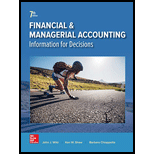
Concept explainers
Sales Discount:
Sales discount is the discount given by the seller to the buyer when the buyer agrees to make the early payment of the goods he bought from the seller.
Credit Period:
It a time period which can pass before the payment is due. It is the time period agreed by both parties that are buyer and seller set up for credit terms.
Discount Period:
Time period in which the customer can avail the cash discount is called discount period. It is the period given to avail cash discount, if the buyer makes the payment in that due period.
Free on Board (FOB) Destination:
The ownership of the good is transferred after the goods are delivered to the buyers address. Seller has the full responsibility of the goods and has to reimburse the amount if any of the goods gets defected.
Free on Board (FOB) Shipping Point:
The ownership of the goods is transferred before the goods are shipped to the buyer. Here, the seller isn’t responsible if the goods get destroyed during the course of delivery.
Gross Profit:
Gross profit is the difference between net sales revenue of the business and the cost of goods sold incurred to earn that revenue. It is the profit after deducting the expenses and cost incurred by the company to make it and sell it afterwards.
Merchandise Inventory:
These are the goods that a company produces and owns and then sell them to the customers. It is an asset. The right amount of inventory helps to improve efficiency of the business.
Purchases Discount:
It is the discount offered by seller to avail it buyer’s promises to pay the amount in a certain time period decided by the seller.
Cash Discount:
It is the discount given by the seller in order to persuade the customer to make the payment in a certain time period.
Trade Discount:
It is the discount that is negotiates at the time of selling the goods. It is the discount given to those people who buy the goods or product in bulk such as retailers, whole sellers.
To Identify: The letter for each definition.
Want to see the full answer?
Check out a sample textbook solution
Chapter 4 Solutions
Financial and Managerial Accounting

 AccountingAccountingISBN:9781337272094Author:WARREN, Carl S., Reeve, James M., Duchac, Jonathan E.Publisher:Cengage Learning,
AccountingAccountingISBN:9781337272094Author:WARREN, Carl S., Reeve, James M., Duchac, Jonathan E.Publisher:Cengage Learning, Accounting Information SystemsAccountingISBN:9781337619202Author:Hall, James A.Publisher:Cengage Learning,
Accounting Information SystemsAccountingISBN:9781337619202Author:Hall, James A.Publisher:Cengage Learning, Horngren's Cost Accounting: A Managerial Emphasis...AccountingISBN:9780134475585Author:Srikant M. Datar, Madhav V. RajanPublisher:PEARSON
Horngren's Cost Accounting: A Managerial Emphasis...AccountingISBN:9780134475585Author:Srikant M. Datar, Madhav V. RajanPublisher:PEARSON Intermediate AccountingAccountingISBN:9781259722660Author:J. David Spiceland, Mark W. Nelson, Wayne M ThomasPublisher:McGraw-Hill Education
Intermediate AccountingAccountingISBN:9781259722660Author:J. David Spiceland, Mark W. Nelson, Wayne M ThomasPublisher:McGraw-Hill Education Financial and Managerial AccountingAccountingISBN:9781259726705Author:John J Wild, Ken W. Shaw, Barbara Chiappetta Fundamental Accounting PrinciplesPublisher:McGraw-Hill Education
Financial and Managerial AccountingAccountingISBN:9781259726705Author:John J Wild, Ken W. Shaw, Barbara Chiappetta Fundamental Accounting PrinciplesPublisher:McGraw-Hill Education





